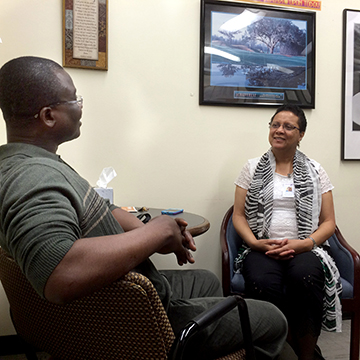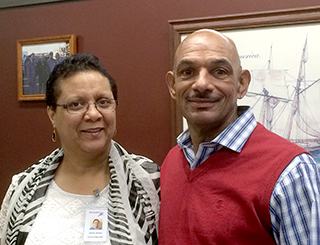Questions compel sister to counseling for chemical and mental abuse
 When asked what keeps her going, what makes her tick, she’ll say it’s her daily 4:45 a.m. hour of meditation. “I couldn’t live as a religious if I didn’t pray, and I couldn’t do the work that I do unless I have God on my side.”
When asked what keeps her going, what makes her tick, she’ll say it’s her daily 4:45 a.m. hour of meditation. “I couldn’t live as a religious if I didn’t pray, and I couldn’t do the work that I do unless I have God on my side.”
The work Sister Jacinta Jackson does is helping Minneapolis, Minnesota’s nonprofit RESOURCE, Inc. realize its mission to “empower people to achieve greater personal, social and economic success” as a clinical counselor of chemical and mental health. She works with more than 20 men, helping them maintain sobriety, sustain recovery and nourish mental health. Her clients are Native Americans, Somalis, Caucasians and Africans who range in age from 20 to 67. Ninety-nine percent of these people she supports leave RESOURCE with no home to go to. And, unfortunately, in the program she serves and others like it across the country, there are more questions about abstaining and upholding and healing than answers. “It’s like putting a bandage on a wound that’s still festering.” What Sister Jacinta does definitively know, however, is that “We must keep the conversation going to help our clients as best as humanly possible.”
Can we identify the cause of chemical abuse? The mental illness that can exacerbate it? “What came first, the addiction, the mental health condition, the domestic violence?” implores Sister Jacinta. She sees factors in the faces of the people she serves. “Most of my clients here started drinking and smoking marijuana at age seven. They often comment that their dad, uncle or mother’s boyfriend was doing it. They were trying to impress, were bored. Is it genetic? Generational? Learned behavior? “Some see it happening around them and think it’s the way to deal with problems—smoke them up or drink them up, self-medicate with drugs or alcohol.” She sees familial circles that some clients have recognized and opted out of. In a group therapy session one client declared she never wants to speak to her mother or father again. “She felt safer on the streets of Chicago,” shares Sister Jacinta, “than in her own home.”
Are addicts resistant to treatment? Laughing at it? The day medical marijuana is legalized in Minnesota, she’s been told in group meetings, “I’m going to be the first one there to smoke it.” Sister Jacinta fires back. “Let’s look at the word ‘medical.’ It’s prescribed for cancer, good for seizures.” No hands are raised when she asks if anyone’s receiving treatment for such illnesses. “So you’re telling me you’re going to take a medication for a disease you do not have? Would you amputate your limb if there’s nothing wrong with it?” Let’s look, she reasons, at non-chemical ways to treat emotional and mental illnesses.
 Can we create a model for recovery? Sister Jacinta and a colleague are discerning and writing a new curriculum, considering five stages of transformation to walk their clients through. There is pre-contemplation: maybe I need treatment. Contemplation: I need treatment. Preparation: I need to start doing something about getting treatment. Action: I’m working on treatment. And finally, maintenance: I will sustain sobriety for a lifetime. How can they help clients to rebuild self-esteem, “a big, big issue,” necessary for motivation? How can relapse be prevented? Along with these factors they’ve identified the essentials of support from groups like Alcoholics Anonymous, Narcotics Anonymous and the Wellbriety Movement: recovery from addiction, counseling for depression, suicide prevention and alcohol rehabilitation born out of Native American culture. For Sister Jacinta, the measure of wellbriety mirrors the modality of spirituality. She’s learning about the Ojibwa way of the medicine wheel and how it can be incorporated into addiction treatment. One of her clients said, “The Great Spirit once gave us life and by taking alcohol and drugs, I was poisoning that life.” Many others have converted to Islam while in prison. Such movement reveals to Sister Jacinta a question of Christianity: “What are we not addressing? What are we missing?”
Can we create a model for recovery? Sister Jacinta and a colleague are discerning and writing a new curriculum, considering five stages of transformation to walk their clients through. There is pre-contemplation: maybe I need treatment. Contemplation: I need treatment. Preparation: I need to start doing something about getting treatment. Action: I’m working on treatment. And finally, maintenance: I will sustain sobriety for a lifetime. How can they help clients to rebuild self-esteem, “a big, big issue,” necessary for motivation? How can relapse be prevented? Along with these factors they’ve identified the essentials of support from groups like Alcoholics Anonymous, Narcotics Anonymous and the Wellbriety Movement: recovery from addiction, counseling for depression, suicide prevention and alcohol rehabilitation born out of Native American culture. For Sister Jacinta, the measure of wellbriety mirrors the modality of spirituality. She’s learning about the Ojibwa way of the medicine wheel and how it can be incorporated into addiction treatment. One of her clients said, “The Great Spirit once gave us life and by taking alcohol and drugs, I was poisoning that life.” Many others have converted to Islam while in prison. Such movement reveals to Sister Jacinta a question of Christianity: “What are we not addressing? What are we missing?”
What works best for people referred to the program by Child Protective Services or those ordered by the court to partici-pate if they relapse and re-incriminate: jail or treatment? Sister Jacinta points to Canada where rates of incarceration are decreasing. Minnesota, she says, is slowly following suit. “Locking people up for nine months, a year, eight years might get them sober but as soon as they walk out of there they find a dealer.” Sister Jacinta adds that clients have come from as far away as North Carolina because Minnesota has one of the best drug programs. And some clients, “sick and tired of being sick and tired,” refer themselves.
What is the level of trust Sister Jacinta’s clients—those willing and ready to acknowledge and accept and commit and work and conserve—have for her? Where is she coming from? What is the ring on her finger? Is she married or not? “It’s an opportunity to explain religious life.” And leads her to ask, “Now that you know I’m a religious, will you have a problem working with me?” The spontaneous response she receives is “no.” “I’ve felt quite humbled when they say ‘We feel safe with you.’ Quite humbled despite all the scandals happening in the church.”
And, perhaps, the most fulfilling and inspiring question of all? “A client asked me how long I’ve been a religious,” recalls Sister Jacinta. “‘For more than 30 years,’ I answered. ‘Thirty years, wow! You’ve given me,’ he said, ‘something to think about.’”
